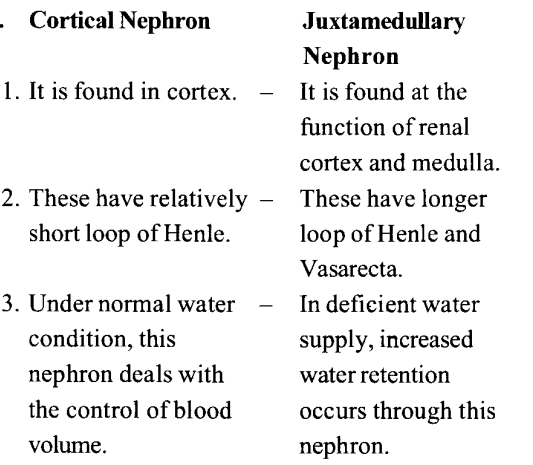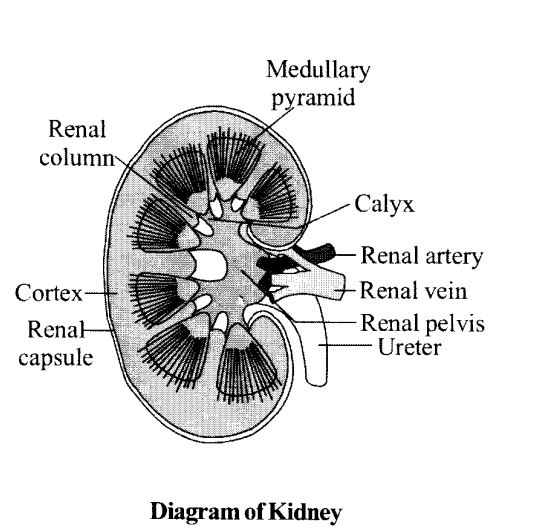NCERT Exemplar Solutions for Class 11 Biology Chapter 19 Excretory Products and their Elimination
These Solutions are part of NCERT Exemplar Solutions for Class 11 Biology. Here we have given NCERT Exemplar Solutions for Class 11 Biology Chapter 19 Excretory Products and their Elimination.
VERY SHORT ANSWER QUESTIONS
Question 1.
Where does the selective reabsorption of glomerular filtrate take place?
Solution:
The selective reabsorption of glomerular filtrate takes place in Proximal Convoluted Tubules (PCT) and Distal Convoluted Tubules (DCT).
Question 2.
What is the excretory product from kidneys of reptiles?
Solution:
The excretory product from the kidney of reptile is uric acid.
Question 3.
What is the composition of sweat produced by sweat glands?
Solution:
Sweat produced by sweat glands is a watery fluid that containing NaCl, small amounts of urea, lactic acid, etc. It’s primary function is to facilitate a cooling effect on the body surface and also to helps in removal of water.
Question 4.
Identify the glands that perform the excretory function in prawns.
Solution:
In prawns, the excretory organs are known as antennary glands or green glands. These glands are white pea sized structures and opaque enclosed in the coxa of each 2nd antenna. They mainly excrete ammonia.
Question 5.
What is the excretory structure in Amoeba?
Solution:
Conractile vacuole performs the function of excretion as well as osmoregulation in amoeba.
Question 6.
The following abbreviations are used in the context of excretory functions, what do they stand for?
(a) ANF
(b) ADH
(c) GFR
(d) DCT
Solution:
(a) ANF Stands for Atrial Natriuretic Factor
(b) ADH Stands for Antidiuretic Hormone
(c) GFR Stands for Glomerular Filtration Rate
(d) DCT Stands for Distal Convoluted Tubule
Question 7.
Differentiate glycosuria from ketonuria.
Solution:
Difference between glycosuria and ketonuria is as follows
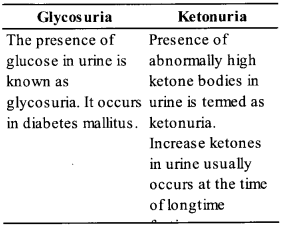
Question 8.
Mention any two metabolic disorders, which can be diagnosed by analysis of urine.
Solution:
Metabolic disorders that can be diagnosed by analysis of urine are
(i) Hematuria- It is a disorder in which blood cells are present in the urine, which could be a sign of kidney stone or a tumor in urinary tract.
(ii) Albuminuria- It is a disorder in which albumin is present in urine and occurs in nephritis i.e., inflammaton of glomeruli. In this condition the size of filtering slits becomes enlarged.
Question 9.
What are the main processes of urine formation?
Solution:
Urine formation includes glomerular filtration (ultra Alteration), selective reabsorption and tubular secretion that occurs in different parts of the nephron.
Glomerular filteration is carried out by glomerulus and is involve the filteration of blood.
Selective reabsorption is the absorption of filtrate through renal tubules either activity or passively.
Tubular secretin involves secretion through tubular cells in urine in order to maintain ionic and acid-base balance of body fluids.
Question 10.
Fill in the blanks appropriately
Organ Excretory wastes
(a) Kidneys ………..
(b) Lungs ………..
(c) Liver ………..
(d) Skin ………..
Solution:
Organ Excretory wastes
(a) Kidneys ——> Urine
(b) Lungs ——> C02
(c) Liver ——> Urea
(d) Skin ——-> Sweat
SHORT ANSWER QUESTIONS
Question 1.
Show the structure of a renal corpuscle with the help of a diagram.
Solution:
The structure of a renal corpuscle is shown below.
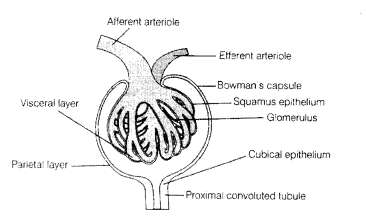
Question 2.
What is the role played by renin-angiotensin in the regulation of kidney frictions?
Solution:
On activation by fall in the glomerular blood pressure/flow renin is released from the Juxta-Glomerular Apparatus (JGA).
It converts angiotensinogen in blood to angiotensin I and further to angiotensin II. Angiotensin II, being a powerful vasoconstrictor, increases the glomerular blood pressure and thereby Glomerular Filteration Rate (GFR). Angiotensin II also activates the adrenal cortex to release aldosterone.
This Aldosterone causes reabsprption of Na+ and water from the distal parts of the tubule. Which leads to an increase in blood pressure and GFR. This complex mechanism is generally known as Renin Angiotensin Aldosterone System of RAAS.
Question 3.
The composition of glomerular filtrate and urine is not same. Comment.
Solution:
Glomerular filtrate contains all the content of the blood plasma except proteins. About 180 litres of glomerular filtrate like water, glucose, nutrients ions etc. occurs. As a result, now the composition of urine is quite different from that of the glomerular filtrate. Some ions are also added to this fluid by tubules i.e. tubular secretion to maintain ionic and acid base balance of body fluids. Thus the composition of glomerular filtrate andd urine is not same.
Question 4.
What is the procedure advised for the correction of extreme renal failure? Give a brief account of it.
Solution:
The ultimate method for the correction of acute/ extreme renal failure (kidney failure) is, Kidney transplantation it is to minimise chances of rejection by the immune system of the host, functional kidney is used as a transplant from a donor, preferably close relative modem clinical procedures have increased the success rate of such a complicated technique.
Question 5.
Explain, why a haemodialysing unit called artificial kidney?
Solution:
- Haemodialysis is a method that become a boon for thousands of uremic (accumulation of urea in blood) patients all over the world. Haemodialysing unit act as artificial kidney by removing urea from patients blood due to kidney failure.
- In this process blood is drained from artery and pumped into a dialysing unit after the addition of an anticoagulant named heparin.
- The unit contains a coiled cellophane tube which is surrounded by a dialysing fluid having the same composition as that of plasma except nitrogenous waste.
- The porous cellophane mfcmbrane of the tube allows the passage of molecules that is based on concentration gradient.
- Absence of nitrogenous water in dialysing fluid these substances freely move out thereby clearing the blood.
- In the end the cleared blood is pumped back to the body through a vein after the addition of anti¬heparin to it thereby completing the process.

LONG ANSWER QUESTIONS
Question 1.
Explain the mechanism of formation of concentrated urine in mammals.
Solution:
Mammals have the ability to produce concentrated urine. The loop of Henle and vasa recta play important role in it which is discussed as follows:
(i) the proximity between the Henle’s loop and vasa recta as well as the counter current that is formed due to the fiow of filtrate in two limp’s of Henle’s loop in opposite direction and help in opposite direction and help in maintaining an increasing osmolality towards the inner medullary interstitium, i.e., from 300 mOsmoL-1 in the cortex to about 1200 mOsmol-1 in the inner medulla.
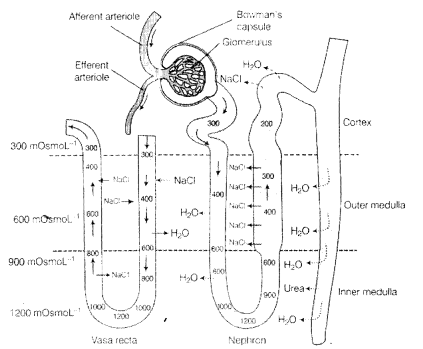
![]()
(ii) This gradient is caused mainly due to NaCl and urea ascending limb of Henle’s loop transports NaCl, that is exchanged with the descending limb of vasa recta.
(iii) Through the ascending portion of vasa recta. NaCl is returned to the interstitium.
(iv) Similarly, a small amount of urea enters the thin segment of the ascending limb of Henle’s loop, which is transported back to the intersitium by the collecting tubule.
(v) This special arrangement of Henle’s loop, and vasa recta, is called the counter current mechanism.
(vi) The rate of dissipation is reduced by the counter current exchange. This in turn, reduces the rate at which the current must pump Na+ to maintain any given gradient.
(vii) Presence of such interstitial garden helps in an easy passage of water from the collecting tubule thereby concentrating the filtrate (urine).
(viii) Human kidneys produces urine nearly four times concentrated than the initial filtrate formed.
Question 2.
Describe the structure of a human kidney with the help of a labelled diagram.
Solution:
- Human kidney are reddish-brown, bean-shaped structures that is situated between the last thoracic and third lumbar vertebra, which is closer to the dorsal inner wall of the abdominal cavity.
- Each kidney of an adult human measures 10-12 cm in length, 5-7 cm in width, 2-3 cm in thickness with an average weight of 120-170 gm
- The kidney is covered by a fibrous connective tissue i.e., the renal capsula, that protects the kidney.
- Internally, it consists of outer dark cortex and an inner light medulla, both containing nephron, nephron is the structural and functional units of kidney.
- The median concave border of a kidney contains a notch called hilum, that functions as route entry and exit of blood vessels, nerves and ureter.
- The renal cortex is granular in appearance that contains convoluted tubules that malpighian corpuscles. The renal medulla contains loop of henle, collecting ducts and tubules and ducts ofBertini.
- Medulla is divided into conical masses, the medullary pyramids that further form papillae.
- The papillae form calyces, which join to renal pelvis leading to ureter. Between the medullary pyramids, cortex extends into medulla and forms renal columns which are called as column of Bertini.
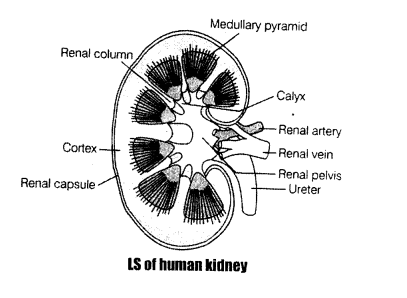
We hope the NCERT Exemplar Solutions for Class 11 Biology at Work Chapter 19 Excretory Products and their Elimination, help you. If you have any query regarding NCERT Exemplar Solutions for Class 11 Biology at Work Chapter 19 Excretory Products and their Elimination, drop a comment below and we will get back to you at the earliest.
